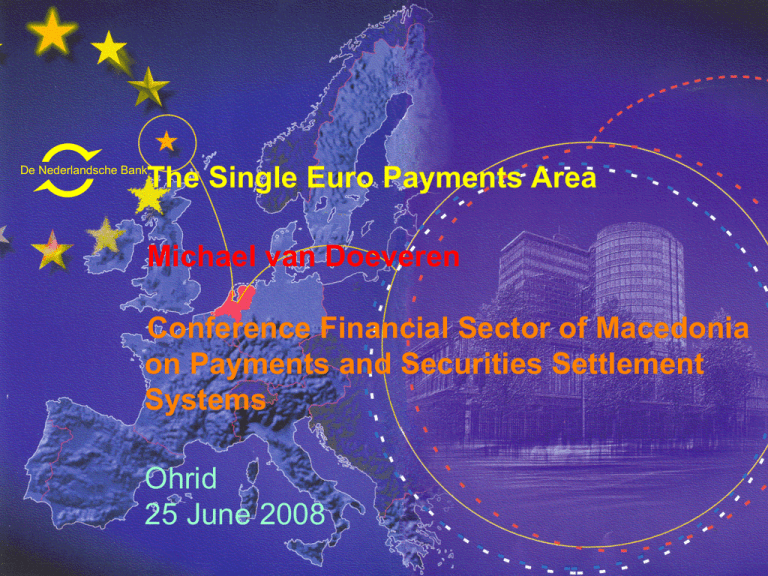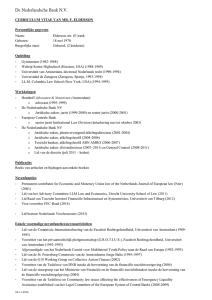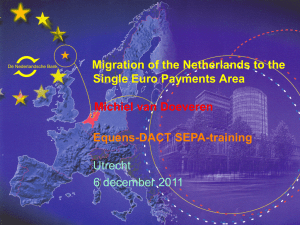SEPA
advertisement

De Nederlandsche Bank The Single Euro Payments Area Michael van Doeveren Conference Financial Sector of Macedonia on Payments and Securities Settlement Systems Ohrid 25 June 2008 De Nederlandsche Bank Eurosysteem Agenda What is SEPA? Why SEPA? How to realise SEPA? Impact of SEPA Uncertainty, concerns and benefits Migration Closing remarks De Nederlandsche Bank Eurosysteem What happened before….. Interaction public sector and banks: 1990 EC paper ´Making payments in the internal market´ 1992 EC paper ´Easier Cross Border Payments – breaking the barriers 1997 EC Directive cross border payments 1999 ECB ´Improving cross border retail payment services´ 1999 introduction euro 2001 Bolkestein regulation (2560/2001) 2001 ECB ´Towards an integrated infrastructure for credit transfers in euro´ 2002 introduction euro coins and banknotes 2002 start EPC 2005 EC concept Payment Services Directive 2006 EPC agreement SEPA Rulebooks and Frameworks … 2008-2010 SEPA…and going on De Nederlandsche Bank Eurosysteem What is SEPA? Single Euro Payments Area De Nederlandsche Bank Eurosysteem De Nederlandsche Bank Eurosysteem What is SEPA? Political vision: The euro area will be an internal ´domestic´ market for retail payments generate scale economies and promoting competition Concretely: European payment instruments for both cross-border and domestic payments in euro: credit transfers, direct debit and cards De Nederlandsche Bank Eurosysteem Why SEPA? European Politics Improvement European economy: Lisbon agenda Economics Internal market: volume and competition Banks To prevent ‘further regulation’ after Regulation 2560/2001 Especially Cross-border banks can profit from new market circumstances De Nederlandsche Bank Eurosysteem The European payment market currently België Belgium Belangrijkste marktpartijen en betaalmiddelen: Duitsland Austria Belangrijkste marktpartijen en betaalmiddelen: Belangrijkste marktpartijen en betaalmiddelen: Beheer van betaalmerken Afnemers van betaaldiensten: Consumenten Winkeliers Bedrij-ven Currence: Consumenten Winkeliers Bedrij-ven Currence: Bank B Bank C Acceptgiro Interpay Overige processoren Griekenland Greece Bank A Bank B Bank C Interpay Consumenten Bedrij-ven Currence: Bank B Bank C Acceptgiro Consumenten Interpay Nederland Netherlands Belangrijkste marktpartijen en betaalmiddelen: Bedrij-ven Currence: Bank A Bank B Bank C Consumenten Interpay Bedrij-ven Currence: Winkeliers Bedrij-ven Currence: Bank B Bank C Acceptgiro Bank B Bank C Interpay Overige processoren Acceptgiro Interpay Overige processoren Aanbieders van betaaldiensten: Bank A Bank B Bank C Currence: Incasso PIN Chipknip Interpay Overige processoren Currence: Beheer van betaalmerken Afnemers van betaaldiensten: Consumenten Winkeliers Bedrij-ven Aanbieders van betaaldiensten: Bank A Bank B Bank C Currence: Incasso Incasso PIN Aanbieders van betaaldiensten: Bank A Bank B Bank C Acceptgiro PIN Chipknip Interpay Verwerker van betaaltransacties: Overige processoren Interpay Overige processoren Spanje Spain Belangrijkste marktpartijen en betaalmiddelen: Beheer van betaalmerken Consumenten Winkeliers Bedrij-ven Currence: Beheer van betaalmerken Afnemers van betaaldiensten: Consumenten Winkeliers Bedrij-ven Aanbieders van betaaldiensten: Bank A Bank B Bank C Currence: Incasso Incasso PIN Aanbieders van betaaldiensten: Bank A Bank B Bank C Acceptgiro PIN Chipknip Verwerker van betaaltransacties: Interpay Acceptgiro Chipknip Portugal Afnemers van betaaldiensten: Acceptgiro Luxemburg Luxembourg Bedrij-ven Chipknip Verwerker van betaaltransacties: Bedrij-ven Belangrijkste marktpartijen en betaalmiddelen: Winkeliers PIN Bank A Chipknip Verwerker van betaaltransacties: Consumenten Incasso Aanbieders van betaaldiensten: Winkeliers Verwerker van betaaltransacties: Belangrijkste marktpartijen en betaalmiddelen: PIN Bank A Overige processoren Beheer van betaalmerken Consumenten Consumenten Beheer van betaalmerken Afnemers van betaaldiensten: Oostenrijk Germany Afnemers van betaaldiensten: Acceptgiro Italië Italy Verwerker van betaaltransacties: Overige processoren Belangrijkste marktpartijen en betaalmiddelen: Winkeliers Interpay Chipknip Incasso Aanbieders van betaaldiensten: Acceptgiro Beheer van betaalmerken Afnemers van betaaldiensten: Chipknip PIN Aanbieders van betaaldiensten: Beheer van betaalmerken Afnemers van betaaldiensten: Bank C Incasso Verwerker van betaaltransacties: Overige processoren Bank B Belangrijkste marktpartijen en betaalmiddelen: Winkeliers Chipknip Verwerker van betaaltransacties: Bank A Beheer van betaalmerken Afnemers van betaaldiensten: PIN Bank A Currence: PIN Aanbieders van betaaldiensten: Verwerker van betaaltransacties: Belangrijkste marktpartijen en betaalmiddelen: Winkeliers Bedrij-ven Incasso Ierland Ireland Incasso Aanbieders van betaaldiensten: Acceptgiro Overige processoren Beheer van betaalmerken Afnemers van betaaldiensten: Winkeliers Chipknip Verwerker van betaaltransacties: Belangrijkste marktpartijen en betaalmiddelen: Consumenten PIN Aanbieders van betaaldiensten: Chipknip Verwerker van betaaltransacties: Beheer van betaalmerken Afnemers van betaaldiensten: Incasso PIN Bank A Frankrijk France Belangrijkste marktpartijen en betaalmiddelen: Beheer van betaalmerken Afnemers van betaaldiensten: Incasso Aanbieders van betaaldiensten: Finland Overige processoren Acceptgiro Chipknip Verwerker van betaaltransacties: Interpay Overige processoren De Nederlandsche Bank Eurosysteem The European payment market – future (SEPA) Main market participants and payment products: Management entity for payment products Users of payment services: Consumers Retail Companies (incl government) Manager (SME) Credit Transfer Direct Debit Providers of payment services: Payment transactions processor: Bank A PEACH Bank B ACH Bank C Bilateral Master card VISA Euro Alliance ? De Nederlandsche Bank Eurosysteem How to realise SEPA? Self-regulation: European Payment Council of banks develops standards and products Payment Services Directive: legal harmonisation De Nederlandsche Bank Eurosysteem EPC Technical harmonisation Two kinds of agreements in EPC: 1. About interbank processing: Credit transfer rulebook Direct debit rulebook 2. Restructuring of the market: SEPA Cards-framework (SCF) Clearing & Settlement Framework SECA De Nederlandsche Bank Eurosysteem EPC Roadmap 2004-2010 Three phases 1. 2004-2006 Design and preparation (EPC) 2. 2006-2008 Implementation and organisation 3. 2008-2010 Dual period of gradual migration De Nederlandsche Bank Eurosysteem SEPA Programme Design & preparation Design & specification 1 Implementation & deployment implementation pilots 2 launch early adopters Co-existence & gradual migration Programme activities national migration programme management, planning, communication, monitoring Milestones 1 2 - SEPA instruments available in market - Critical mass migrated/SEPA irreversible subject to the commitment of all stakeholders De Nederlandsche Bank Eurosysteem Milestones Credit transfer and Direct debit European Rulebooks are the basis for products of the banks Framework for clearing and settlement Credit transfers from 28 January 2008 on Direct debit from end 2009 on Cards SEPA Cards Framework After 2010 only SEPA-cards De Nederlandsche Bank Eurosysteem Role public sector SEPA is a project banks: self-regulation via EPC However… European Commission Payment Services Directives Public users are the early adopters Eurosystem: catalyst role 5th Progress report July 2007 De Nederlandsche Bank Eurosysteem Legal harmonization: Payment Services Directive Content: Proportional supervisory regime for nonbank payment service providers Transparency requirements Rules about the relationship of the payment service provider and user De Nederlandsche Bank Eurosysteem Role of NCBs To ensure a smooth migration to SEPA Self-regulation: banks are in the lead Policy development and monitoring in the Eurosystem Monitoring national implementation Organizing stakeholder involvement (e.i. Consulting group SEPA NL) Analysis, communication and planning De Nederlandsche Bank Eurosysteem Trends in payments in the EU De Nederlandsche Bank Eurosysteem Potential for SEPA compliancy NL Non SEPA Compliant instruments 9% SEPA Credit Transfers 29% SEPA Cards 36% SEPA Direct Debits 26% De Nederlandsche Bank Eurosysteem Impact of of SEPA Consumers Use IBAN and BIC Use of cards in the whole SEPA area Firms (private and public) Easier cash-management and administration Standard formats (ISO 20022 XML) Use of IBAN and BIC Centralisation of accounts and direct debits Retailers More choise: terminal, acceptance of brands, acquiring Banks Change of markets, new products, new systems De Nederlandsche Bank Eurosysteem Hurdles! Uncertainties: No concrete products offered! Legal framework in preparation Concerns: User adoption of SEPA products Price development (cards!) Maintaining existing efficiencies Continuity of payments De Nederlandsche Bank Eurosysteem Benefits of SEPA Efficiency, level playing field and transparency lead to cost benefits for society in the long run Reduction costs for average user of payment services in Europe Comfort/User-friendliness Innovation De Nederlandsche Bank Eurosysteem Migration Aim: a smooth migration to SEPA To organise nationally Market driven Speed can differ between countries Stakeholder involvement and communication are important tools for success De Nederlandsche Bank Eurosysteem Transition plan of the Netherlands Objective: an orderly and efficiently change over from domestic payments to SEPA Scope: all existing payment instruments Consequences and choices for different stakeholders Market driven migration Identifying barriers and changes Mid 2009 evaluation of the migration and choice about phasing out domestic instruments De Nederlandsche Bank Eurosysteem Points of concern SEPA National Forum on the Payment System Price developments Range of options open to consumers and retailers, caterers and other regarding debit card brands User-friendliness of migration to IBAN and BIC Safety of SEPA direct debit Prolongation of direct debit contracts and mandates Standardisation in the Bank-client domain Interbank Swich support service Dispute handling Accessibility of the noncash payment system Consultation process De Nederlandsche Bank Eurosysteem Fifth SEPA progress report Eurosystem July 2007 (messages) Complete Clarity needed on all features of SEPA Direct Debit by December 2007 Further card standardisation is vital Need for one additional European Debit card scheme Co-branding can help card schemes to gain the time needed for the development of a long-term strategy Infrastructures should comply with SEPA-compliance criteria Security of SEPA payment instruments needs to receive more attention Reachability is the key De Nederlandsche Bank Eurosysteem Closing remarks The first phase of SEPA (SCT) was introduced succesfully on 28 January 2008 SEPA will transform the European landscape SEPA is good and has benefits for all users! But cost come first… Implementation and transition will be planned carefully User involvement has to be stimulated SEPA is the start for new developments: e-invoicing, e- and m-payments etcetera De Nederlandsche Bank Eurosysteem

